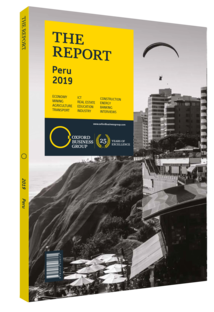Peru sees trade surplus after rise in non-traditional exports
According to the Central Reserve Bank of Peru, the country’s trade surplus increased further in 2018, to $7.6bn, the highest figure since 2011 and the fourth biggest on record. Though the trade balance was down from $1.9bn to $1.2bn in the first quarter of 2019, economists are still predicting a surplus. According to Guillermo Arbe, head of economic studies at Scotiabank Perú, the surplus is set to end the year at $5.5bn.
This expansion in trade was driven in large part by rising agri-business exports, with increased production supported by the application of new technologies, new uses of land and better irrigation practices. Overall, exports grew by 5.6% in real terms in 2018, despite so-called traditional exports — dominated by copper but also including other metals, oil and gas, coffee and sugar — growing by 1.7% in constant prices, according to the National Institute of Statistics and Informatics. Meanwhile, non-traditional exports, including agri-business, textiles and chemicals, were up 17.3%.
Rising Exports
This growth follows nearly two decades of export expansion, with the total value of exports growing sevenfold, from $7.6bn to just over $51.2bn, between 1998 and 2017, according to the World Bank. Although this figure did fall between 2012 and 2015 as the result in falling international commodity prices. The Ministry of Economy and Finance forecast this figure will rise further, to $67.4bn by 2022.
“Peru’s export sector is going extremely well because the country has done a great job of developing non-traditional exports,” César Peñaranda Castañeda, executive director at the Institute of Economy and Business Development of the Lima Chamber of Commerce, told OBG. “It is a real success story for Peru’s exporters that they have been able to show impressive growth despite the logistical costs and infrastructure required.”
A key advantage of having a diversified portfolio of exports is the ability to mitigate the impact of business cycles, particularly in terms of international metal and mineral prices. Crucially, the improvement in Peru’s trade balance has helped the country narrow its current account deficit from 5% of GDP in 2015 to 1.5% in 2018. A great deal of this is down to impressive growth in agri-business exports, with the value of Peru’s non-traditional agricultural exports having increased from under $400m in 2000 to $5.9bn in 2018. Furthermore, Agri-business has also become a source of foreign currency, driven by free trade agreements, more flexible labour legislation and a deliberate government development strategy.
Opening Windows
A key policy that has facilitated the expansion of Peru’s foreign trade is implementation of the Single Window for Foreign Trade, (Ventanilla Única de Comercio Exterior, VUCE), which began in 2006. The policy has effectively integrated 260 trade processes from 15 public entities, according to the government’s National Competitiveness and Productivity Policy report released in January 2019. However, the VUCE has faced challenges in terms of evolving in step with changing market dynamics. Furthermore, high logistics costs caused by underdeveloped hard infrastructure have placed the country at a disadvantage when developing more efficient supply chains.
Nevertheless, Peru has partially offset this impact through its stable commitment to free trade and its openness to international investment. Around 90% of its trade derives from 53 countries, covered by 20 free trade agreements. Peru has been a major beneficiary of the rising economic development of China, with the total value of trade between the two countries reaching a record $23bn in 2018, according to the Ministry of Foreign Trade and Tourism. Notably, non-traditional exports from Peru to China grew by 17% in 2018. As part of an effort to further deepen these trade ties, Édgar Vásquez, the minister of foreign trade and tourism, visited China in April 2019 to participate in the Belt and Road Forum and sign a memorandum of understanding outlining a commitment to deepen trade and integration ties between the two partners.
You have reached the limit of premium articles you can view for free.
Choose from the options below to purchase print or digital editions of our Reports. You can also purchase a website subscription giving you unlimited access to all of our Reports online for 12 months.
If you have already purchased this Report or have a website subscription, please login to continue.

